🌿 Finding Calm Through Nature and Mindfulness
Cuyahoga Valley National Park
In a world filled with constant noise, screens, and deadlines, many of us forget one of the most natural forms of healing available to us—stepping outside. Whether it’s a quiet walk around the neighborhood or the sound of the birds in the morning, spending time in nature has a profound impact on mental health and overall well-being.
Research consistently shows that being in nature lowers stress hormones, reduces symptoms of anxiety and depression, and improves focus and mood. Simply breathing in fresh air or noticing the rhythm of waves or rustling leaves can help calm an overactive nervous system.
Nature has a way of reminding us that we are part of something bigger, grounding us when life feels overwhelming.
As a therapist, I often encourage clients to bring mindfulness into their time outdoors. This can mean taking a short walk without your phone, noticing the colors and sounds around you, or simply sitting quietly and observing your breath as you take in your surroundings. These moments help us slow down, reconnect with ourselves, and find perspective.
🌿
You don’t need to live near a forest or mountain to benefit. A neighborhood park, garden, or even sitting outside with your morning coffee can create space for restoration. For those in the Cleveland area, hiking trails such as those found on AllTrails Cleveland are a wonderful option. My personal favorite is Huntington Beach, which provides a peaceful place to meditate and achieve a sense of calm by the beautiful Lake Erie. For those outside the area, a helpful resource for hiking trails and nature spots across Ohio can be found at AllTrails Ohio.
As the leaves gently change into their beautiful fall foliage, open the door, breathe deeply, and take a step outside.
🌿
If you find yourself struggling with stress, anxiety, or other mental health challenges, therapy can provide a safe space to explore your feelings and develop coping strategies.
I’d be honored to support you on your journey toward greater calm, clarity, and connection.
For an extra nature-based mindfulness exercise, try this next time you are outdoors:
Take a deep breath and choose something healing to focus on. It could be your breath as you walk, the feeling of your feet on the ground, or the beauty that surrounds you. As anxious thoughts or worries arise, try noticing them without judgment—allowing them to flow by like a river—and gently bring your attention back to your breath and the natural beauty around you.
📚 References
Berto, R. (2014). The Role of Nature in Coping with Psycho-Physiological Stress: A Literature Review on Restorativeness. Behavioral Sciences, 4(4), 394–409. https://doi.org/10.3390/bs4040394
Alcock, I., White, M.P., Wheeler, B.W., Fleming, L.E., & Depledge, M.H. (2014). Longitudinal effects on mental health of moving to greener and less green urban areas. Environmental Science and Technology, 48(1), 1247–1259.
Djernis, D., Lundsgaard, C.M., Rønn-Smidt, H., & Dahlgaard, J. (2020). Nature-Based Mindfulness: A Qualitative Study of the Experience of Support for Mental Health.


